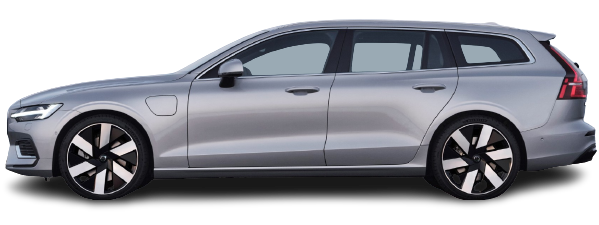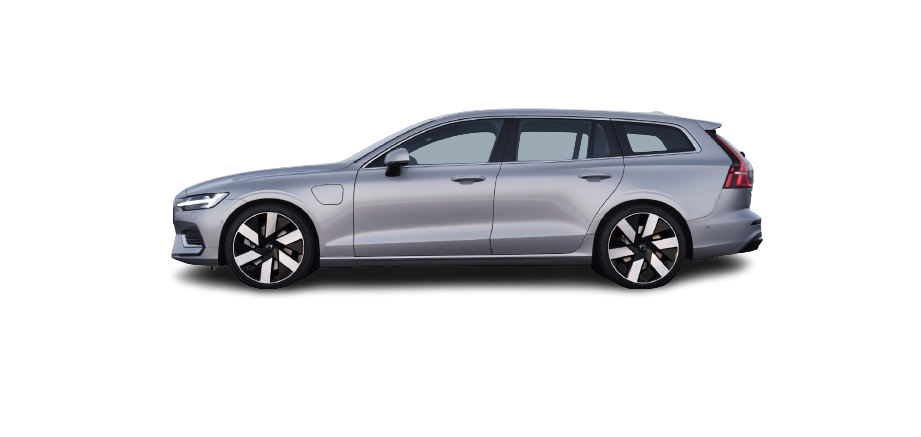2023 Volvo V60 Driver support

Driving support systems
For example, the systems can help the driver to:
- use steering assistance to reduce the risk of accidentally leaving the lane or colliding with another vehicle
- maintain a set speed
- maintain a certain time interval to the vehicle ahead
- prevent a collision by giving a warning to the driver and braking the car
- parking.
Some of the systems are fitted as standard while others are options – which alternative applies is market dependent.
Some of the systems have improved functionality when Google Maps is used.
- The driver support systems are only supplementary aids – they cannot handle all situations in all conditions.
- The driver always bears responsibility that the vehicle is driven safely and that applicable road traffic rules and regulations are followed.
Warnings from various driver support systems
There are several functions in your car that can contribute actively to increasing safety in traffic, both for yourself and other road users. You have the option of viewing a list of some of the functions and what they may do – the aim of this is to ensure you are not surprised by the activation of any of the functions. If a function should be activated, you can also be informed of this via a text message in the driver display.
Read the individual sections on each system in order to fully understand the functions and learn about important warnings.
The driver support functions in your car can alert you in different ways. For example, with vibration in the steering wheel, brake pulse, with visual or acoustic signals or via symbols in the driver display.
Alerts can also be shown in the head-up display.
- Assistance at risk of collision can assist the driver to avoid or mitigate a collision with a warning, automatic braking and steering assistance.
- Your experience of the function may therefore differ depending on which subfunction is activated.
- Assistance at risk of collision can perform the following steps if necessary:
- Collision warning
- Assisted braking
- Automatic braking
- Steering assistance

Lane assistance can help you to reduce the risk of the car unintentionally leaving its own lane.
- Steering assistance: If the function detects that the car is approaching a lane line, you will feel a gentle steering action applied to the steering wheel. You must have both hands on the steering wheel for the function to work.
- Warning: If the function detects that the car is approaching a lane line, you will be alerted by vibration in the steering wheel.
- Both: You are alerted with vibration and a gentle steering action applied to the steering wheel.
- Intensive flashing with the direction indicators.
- At low speeds the function can tension the seatbelts by activating the seatbelt tensioners, and also activate the Whiplash Protection System.
- If the car is stationary, the foot brake can be activated.

- Alerts with an indicator lamp in the side mirror, with fixed glow and flashing light.

The function is intended to attract the driver’s attention if he/she starts to drive less consistently, e.g. if he/she becomes distracted or starts to fall asleep.
- Acoustic signal combined with a symbol in the driver display and a message.
Distance WarningDistance Warning can alert you if the time interval to the vehicle ahead suddenly becomes too short.
- Warning symbol in the windscreen Head-up display. To have the function, the car must be equipped with a Head-up display.

There are two functions that can assist the driver to prevent a collision while reversing.
- Cross Traffic Alert (CTA) is designed to alert for crossing traffic when the car is being reversed.
- Rear Auto Brake (RAB) is intended to help the driver detect stationary obstacles that may be directly behind the car when it is being reversed.
If obstacles are detected:
- A warning signal and the graphic for parking assistance illuminate to indicate the position of the obstacle.
- If the driver does not pay attention to the warning and a collision is unavoidable, the car is auto-braked and an explanatory text message is shown for why the car was braked.
Speed-dependent steering force
In rare situations, the power steering may need to work at reduced power, and turning the steering wheel may then seem slightly heavier. This may occur when the power steering becomes too hot and it then needs temporary cooling. It may also occur if the power supply is disrupted.

- In the event of reduced power, the message Power steering assistance Temporarily reduced is shown, as well as this symbol in the driver display.
- While the power steering is working at reduced power, the driver support functions and steering assistance systems are not available.
If the temperature increases too much, the servo may be forced to switch off completely. In such a situation, the driver display shows the Stop safely Power steering failure message, combined with a symbol.
- Press
 in the centre display.\
in the centre display.\ - Then tap on Driving.
- Activating or deactivating Steering feel firm.
Steering wheel resistance selection can only be accessed if the car is stationary or is moving at low speed and in a straight line.
Ready to drive notification
- In order not to be stationary for too long and hold up the traffic, the Ready to drive notification function gives an acoustic signal and shows a symbol and message in the driver’s display. The notification may not be given if the system detects pedestrians or cyclists in the vicinity of the car.
However, the system cannot detect pedestrians and cyclists in all situations. The driver always bears responsibility for ensuring that the car is driven safely.
To activate or deactivate the function:
- Press
 in the centre display.
in the centre display. - Tap on Driving and change the desired setting.
- The function is supplementary driver support intended to facilitate driving and make it safer – it cannot handle all situations in all traffic, weather and road conditions.
- The driver is advised to read all sections in the Owner’s Manual that relate to this function to learn about factors such as its limitations and what the driver should be aware of before using the system.
- Driver support functions are not a substitute for the driver’s attention and judgement. The driver is always responsible for ensuring the car is driven in a safe manner, at the appropriate speed, with an appropriate distance to other vehicles, and in accordance with current traffic rules and regulations.
This function uses the car’s radar and/or camera units, which have some general limitations.
- After a serious collision there is a risk that it is no longer possible to control and steer the car. In order to avoid or mitigate a possible further collision with a vehicle or an object in the vehicle’s path, the auto braking system is activated automatically and brakes the car in a safe manner.
- Brake lights and hazard warning lights are activated during braking. When the car has stopped, the hazard warning lights continue to flash and the parking brake is applied.
- If braking is not appropriate, e.g. if there is a risk of being hit by following traffic, the system can be overridden by the driver depressing the accelerator pedal.
- The function assumes that the brake system is intact after the collision.

